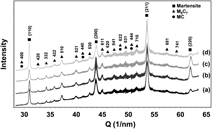Article contents
Micrometer-scale synchrotron diffraction mapping analysis of carbide precipitation in deep cryogenically treated low carbon steel
Published online by Cambridge University Press: 18 May 2012
Abstract

Carbide precipitation within low carbon AISI H13 hot work tool steel that had either been quenched at 80 °C or cryogenically treated at −196 °C prior to tempering has been examined using micrometer-scale synchrotron diffraction mapping. Vanadium-rich cubic M8C7 carbide, lattice parameter of approximately 0.8610 nm, not identifiable using laboratory powder x-ray diffraction (PXRD), was found to be present in all samples. The concentration of this phase was greatest in the rapidly cooled cryogenically treated sample. However, all cryogenic treatments resulted in greater carbide concentrations than in the quenched sample. In addition rapid cryogenic cooling by immersion in liquid nitrogen (N2), as compared with slow cooling to −196 °C over a 3 h duration, results in greater order within the carbide phase subsequent to tempering, as interpreted by analysis of unit cell size variation, and the smallest stress, as interpreted by diffraction peak full width half maximum height distributions.
- Type
- Articles
- Information
- Copyright
- Copyright © Materials Research Society 2012
References
REFERENCES
- 3
- Cited by




